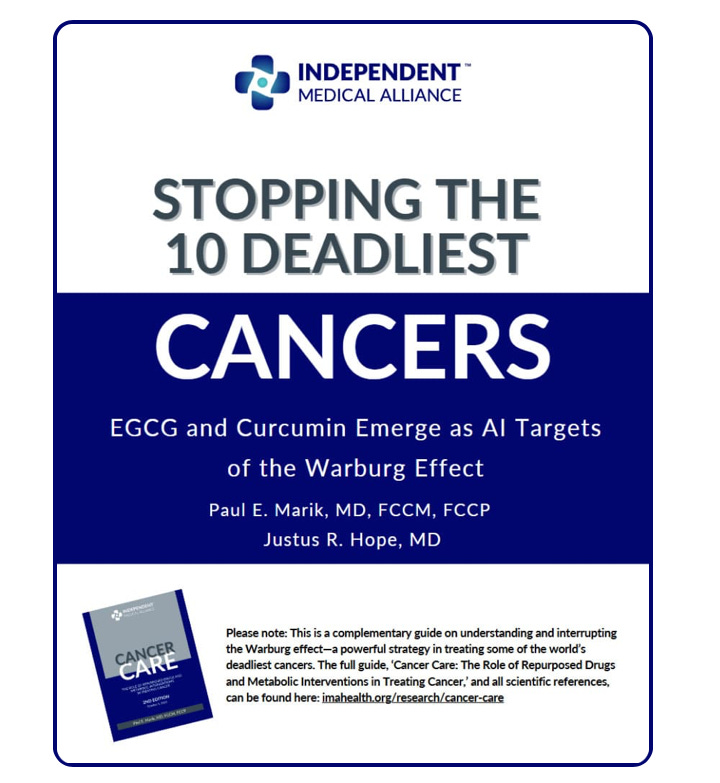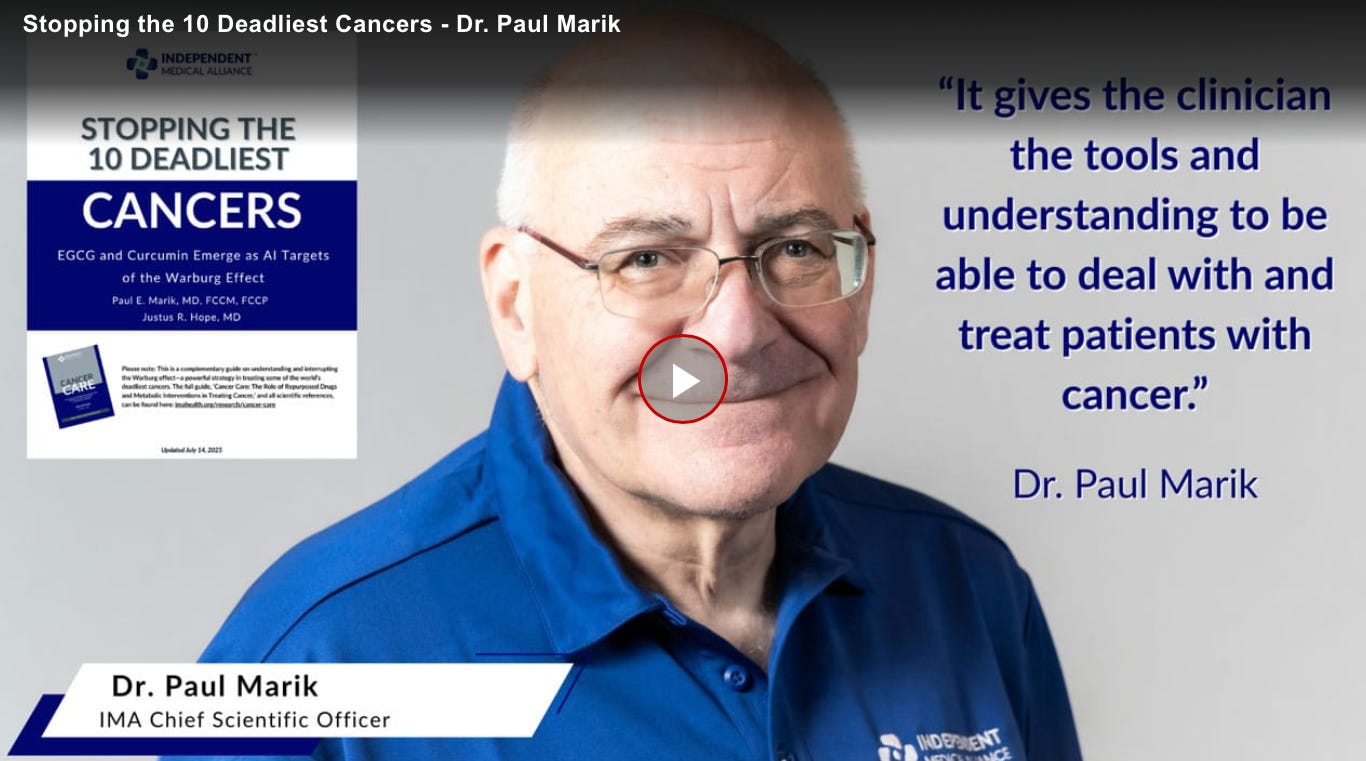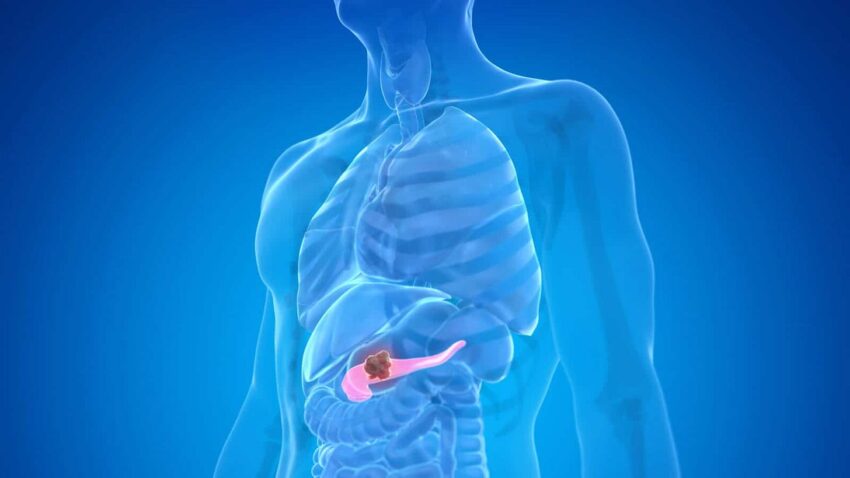This article originally appeared on Independent Medical Alliance (formerly FLCCC) and was republished with permission.
Guest post by Independent Medical Alliance
The 10 deadliest cancers share one thing: a common metabolic driver. Learn how repurposed drugs can help stop them, and download the free guide by Dr. Paul Marik and Dr. Justus R. Hope.
Each year, cancer takes more than 600,000 lives in the United States and 10 million globally. It’s the second-leading cause of death in America, and the rates are not going down. Despite massive fundraising campaigns and billion-dollar research budgets, meaningful innovation in cancer treatment has stalled.
In fact, most patients today are still offered the same three options they would have been decades ago: surgery, chemotherapy, and radiation.
But what if there’s more we can do to treat it? And what if we could find ways to enhance traditional treatments, all while reducing their toxicity?
At the Independent Medical Alliance (IMA), we believe it’s time to bring real innovation to the fight against cancer. That’s why Dr. Paul Marik—IMA Co-Founder and author of Cancer Care—teamed up with Dr. Justus R. Hope and created a new companion guide focused on interrupting the lethal mechanisms behind the 10 deadliest cancers. Using cutting-edge metabolic science and repurposed medicines, this guide delivers something few institutions have: a path forward.
Download the free guide, or keep scrolling for a summary written for patients and curious doctors alike.

📋 The 10 Deadliest Cancers
Using AI and molecular profiling, Dr. Marik and Dr. Hope identified the cancers with both the lowest survival rates and the highest metabolic aggression measured by how strongly they activate cancer’s most destructive pathways (powered by the Warburg Effect, explained further below).
Here they are:
-
Pancreatic cancer
-
Small-cell lung cancer
-
Glioblastoma
-
Liver cancer (HCC)
-
Acute myeloid leukemia
-
Esophageal cancer
-
Stomach cancer
-
Ovarian cancer
-
Mesothelioma
-
Gallbladder cancer
These cancers don’t just grow fast. They exploit your body’s own systems to shield themselves from attack, spread more easily, and bounce back after treatment. Because these cancers are so deadly, they require a more comprehensive understanding to treat and prevent recurrence.
#ad: Your diet isn’t perfect—and that’s okay.
Global Healing’s Organic Multivitamin is here to help you fill the gaps with over 30 essential vitamins and minerals your body needs to feel its best.
There are no coatings, no fillers—just clean, high-quality nutrients your body can actually use. It’s a simple, effective way to support your daily health and give your body the care it deserves.
Experience the difference you can actually feel. Use code VFOX at checkout for 10% off your order.
DISCLOSURE: This is an affiliate link. I may earn a commission if you make a purchase here, at no additional cost to you.
⚠️ Why Are These Cancers So Deadly?
So why are these cancers so deadly? The answer lies in their metabolism.
Unlike normal cells, many cancer cells ferment glucose for energy, even when oxygen is available. This is a phenomenon known as the Warburg Effect. This sugar-burning state produces acid, feeds inflammation, rewires energy pathways, and suppresses immunity.
“…the GLUT1 pathway, the hexokinase pathway, the HIF-1 pathway, and the c-Myc pathway. So those pathways or those enzymes involved in the Warburg effect are most active in patients with the 10 deadliest cancers.” —Dr. Paul Marik
This metabolic hijacking allows these cancers to:
-
Grow rapidly
-
Invade nearby tissue
-
Resist chemotherapy
-
Recruit new blood vessels
-
Recurrence even after remission
To stop them, we must understand and disrupt these drivers.
💡 Why We Created This Guide
Dr. Marik’s book Cancer Care is a bestselling cancer book on Amazon. And as amazing as it is, this book was always intended to be a “monograph,” a dense curation of cancer care research with a dizzying number of academic citations.
Cancer Care was written for those who want to understand every mechanism and molecule. But for those seeking practical guidance, something they can apply or share, Dr. Marik has committed to creating a series of companion guides.
This guide is the second in that series; the first was titled “The Approach to Repurposed Drugs for Cancer.” These additional resources are designed to help turn Cancer Care’s research into clinical action. Here’s who could benefit:
-
Integrative oncologists who want to bring more to the table
-
Patients and families who want to share credible strategies with their doctors
-
Medical professionals ready to break out of the “standard-of-care” box
This is science in action, offered freely, built from evidence, and focused on improving outcomes now.

🔬 The Metabolic Drivers of Cancer
These cancers aren’t just deadly because of their location or size. They’re driven by powerful metabolic distortions. Think of these distortions like feedback loops and molecular misfires that make them harder to treat, quicker to grow, and more likely to return.
Below, we unpack the three most dangerous metabolic drivers uncovered in our research—and how we can stop them.
🧪 Lactic Acid and HIF-1 Create a VEGF Feedback Loop
This may seem like advanced biology, but bear with us. There’s something called HIF-1 that can potentially drive blood vessel growth to cancerous tumors. That’s a problem because the cancer will be able to feed and grow more easily.
Here’s how it all works:
-
Cancer cells produce excess lactate, which triggers HIF-1 activation even in oxygen.
-
HIF-1 drives blood vessel growth (VEGF), feeding the tumor and creating a dangerous feedback loop.
-
Table 2 (seen below) from the guide lists repurposed agents that block this process, including:
-
EGCG (green tea extract)
-
Resveratrol
-
Curcumin
-
Metformin
-
Simply put, reducing HIF-1 can help disrupt the tumor’s ability to grow, spread, and evade treatment. The substances listed above are low-toxicity, low-cost compounds that are already available, already studied, and ready to use.
🧬 The c-Myc and GLUT1 Sugar Trap
There’s a gene called “c-Myc” that increases something called GLUT1, a glucose transporter. When GLUT1 is around, cancer cells have easy access to sugar. That’s when they can start growing at a rapid rate.
Here’s how that works in a nutshell:
-
The gene c-Myc hijacks the cell’s sugar channels by increasing GLUT1, a glucose transporter.
-
This lets cancer cells gorge on sugar, fueling runaway growth and suppressing normal cell function.
-
The guide identifies compounds that shut this down, including:
-
EGCG
-
Quercetin
-
By cutting off cancer’s fuel supply, we can slow its spread and even make chemotherapy more effective.
And for those keeping score, EGCG (from green tea) shows up again and again in the data. It’s one compound that may deserve a place in nearly everyone’s health routine, cancer diagnosis or not.
⚙️ The Warburg Effect: Cancer’s Metabolic Engine
Dr. Marik has often reminded us: cancer is, at its core, a metabolic disease. That idea. first championed by Dr. Thomas Seyfried, is what inspired him to take a more in-depth look at cancer research in the first place. And we owe Dr. Seyfried a thank-you for that because it ultimately led to the creation of Cancer Care.
Everyone’s metabolism is different, but some cancer-related processes are well understood.
One of the most important is the Warburg Effect, a metabolic shift that helps cancer cells thrive. At the center of it is the PI3K/AKT/mTOR pathway, which acts like a control hub for cancer growth and energy use.
Naturally, it’s a prime target for intervention—but it’s also a major missed opportunity, since most patients are never told this pathway can be addressed alongside standard treatment.
Here’s a quick primer on the Warburg Effect:
-
The PI3K/AKT/mTOR pathway is cancer’s control center for metabolism and cell growth.
-
This pathway regulates the Warburg Effect itself and is activated in nearly all aggressive tumors.
-
Table 5 (in the downloadable guide) lists potent inhibitors of this pathway:
-
Curcumin
-
IV Vitamin C
-
EGCG
-
Metformin
-
Atorvastatin
-
This is where repurposed drugs shine: they target the same pathways as some of the newest cancer drugs, without the price tag or side effects.
💊 Common Cancers and Repurposed Ivermectin
In the final section of the guide, Dr. Marik shares a striking finding: many of the world’s most common cancers are also driven by mechanisms that respond to a repurposed drug our audience will no doubt be familiar with: ivermectin.
These include:
-
Lung
-
Breast
-
Colorectal
-
Prostate
-
Stomach
-
Cervical
-
Thyroid
-
Bladder
-
Lymphoma
While mainstream medicine may ignore ivermectin’s role in cancer, preclinical and early clinical studies are revealing powerful synergy with existing treatments. In addition to that, there’s potential to use ivermectin to overcome drug resistance, suppress metastasis, and trigger immune activation.
📣 Real Answers Exist… But They Aren’t Being Funded.
The problem isn’t a lack of solutions; it’s a lack of support.
The biggest cancer charities raise billions. But where is the innovation? Where are the guides that empower doctors and patients to act now?
At IMA, we do things differently. With limited resources and no pharmaceutical funding, we’ve already delivered:
-
Cancer Care: our comprehensive treatment guide, downloaded tens of thousands of times worldwide
-
A bestselling cancer treatment book on Amazon
-
A growing library of free, actionable tools for patients and practitioners
But we can’t do it alone. Whether you’re a patient, caregiver, or practitioner, your support fuels the next guide, the next breakthrough, and the next life saved. Please share this article. Download the guide. And if you can, support this work:
More Live-Saving Cancer Resources:
-
Webinar: Cancer as a Metabolic Disease
-
Webinar: Cancer Care: Research and Insights from the Frontline
-
Post: Practical Cancer Solutions: “40% of Cancers are Preventable”
Copyright 2025 Independent Medical Alliance
Click this link for the original source of this article.
Author: The Vigilant Fox
This content is courtesy of, and owned and copyrighted by, https://vigilantfox.substack.com and its author. This content is made available by use of the public RSS feed offered by the host site and is used for educational purposes only. If you are the author or represent the host site and would like this content removed now and in the future, please contact USSANews.com using the email address in the Contact page found in the website menu.
















